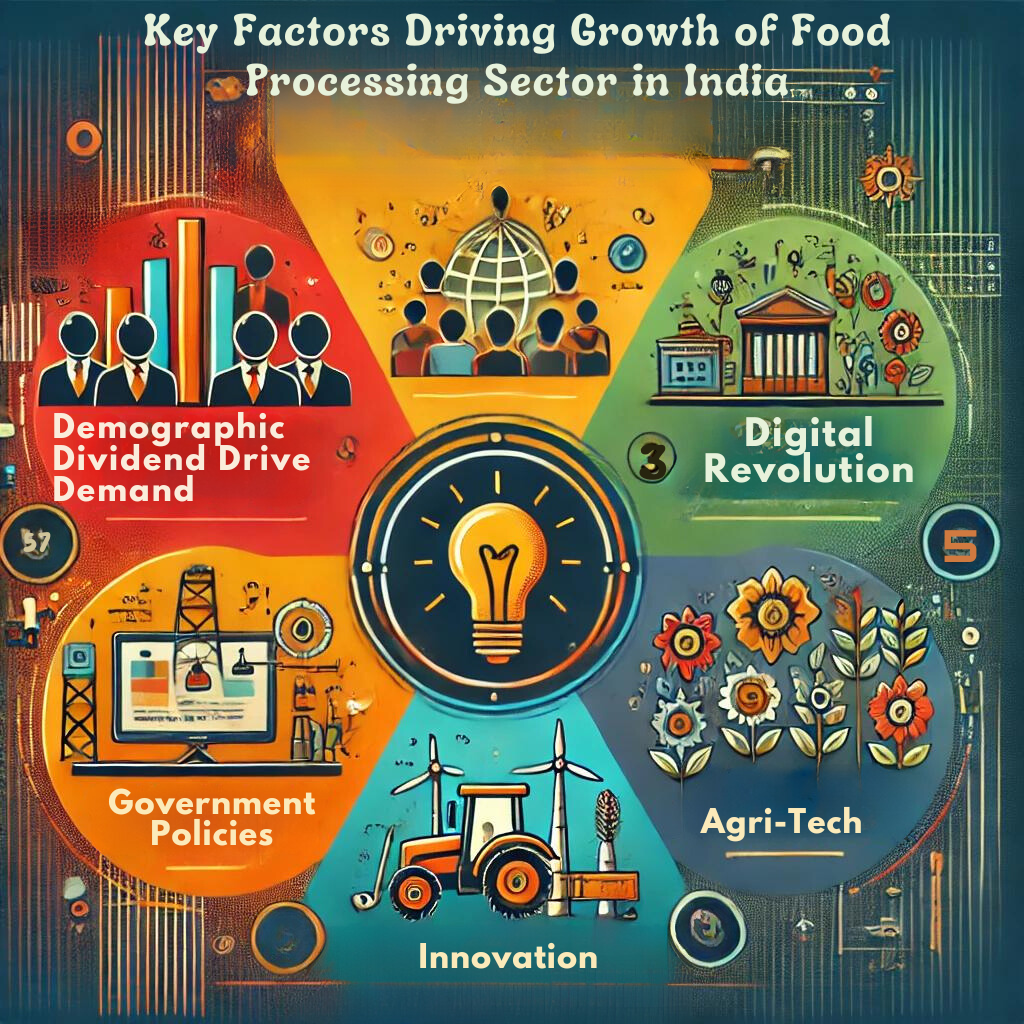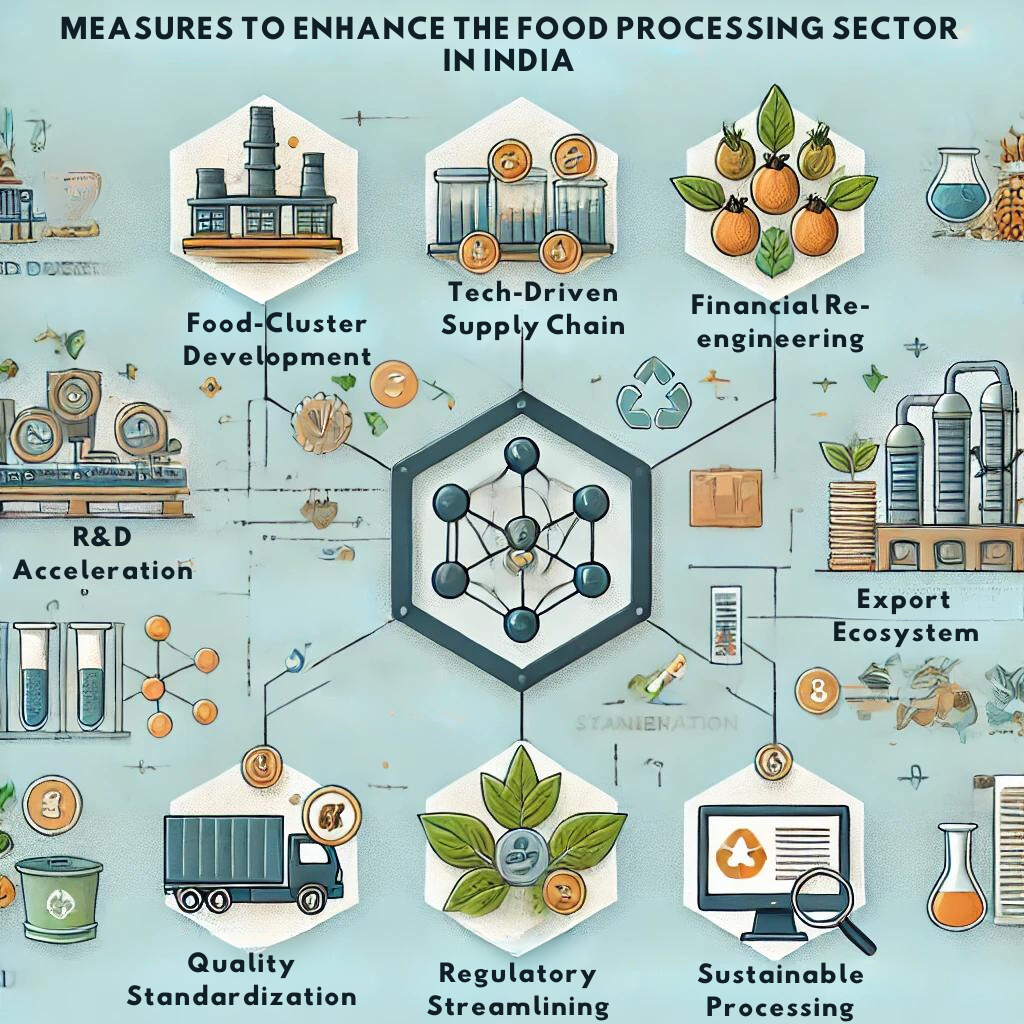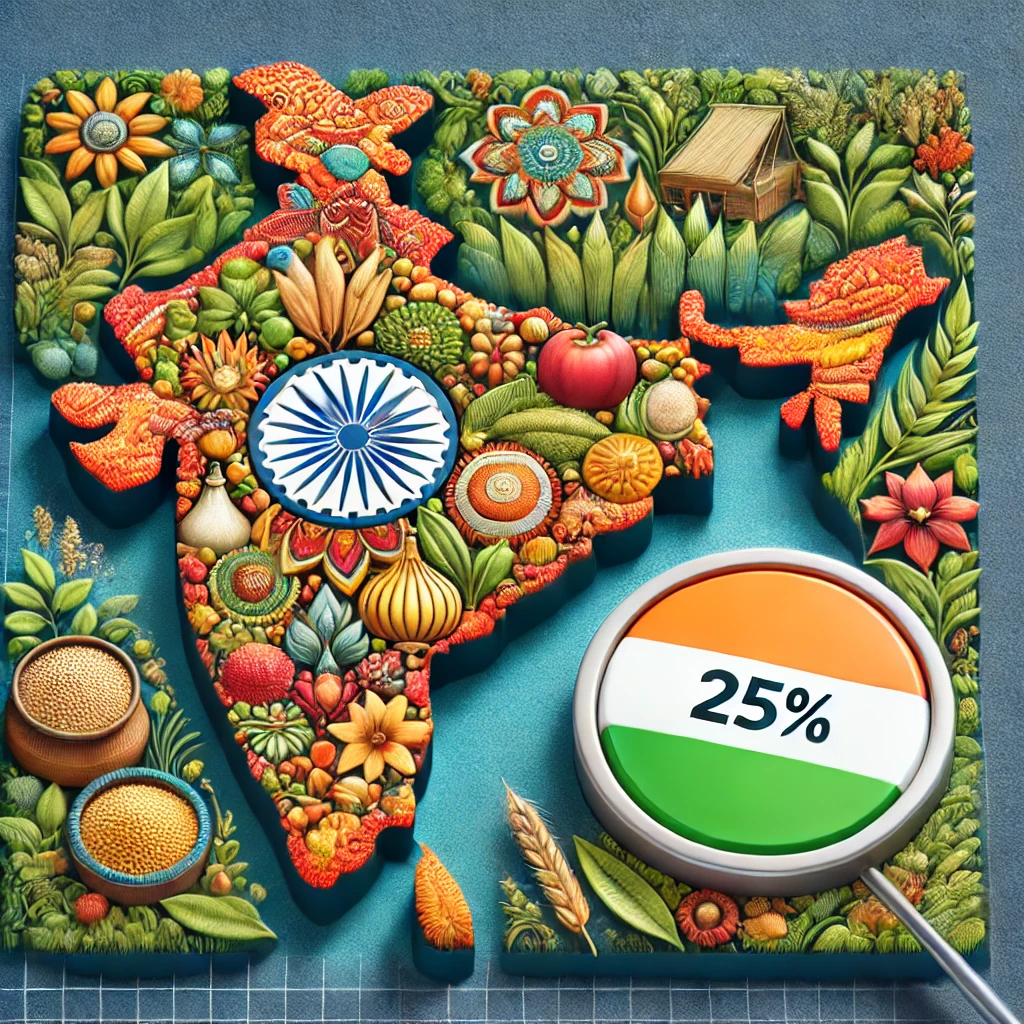India’s food processing sector is important, with immense growth and export expansion potential. Despite the government’s substantial budget allocation of ₹1.52 lakh crore in 2024-25 for agricultural development, agri-exports remain underperforming. Only 25% of agricultural exports are processed or value-added products, a figure that has stagnated for a decade. This lag presents both a challenge and an opportunity for the industry to tap into its full potential and compete globally.
| GS Paper | General Studies III |
| Topics for UPSC Prelims | India’s food processing sector, Production Linked Incentive Scheme for the Food Processing Industry, FDI allowance in food processing, FSSAI, Agricultural and Processed Food Products Export Development Authority, Bureau of Indian standards, Pradhan Mantri Kisan Sampada Yojana, Pradhan Mantri Formalisation of Micro Food Processing Enterprises Scheme |
| Topics for UPSC Mains | Key Factors Driving the Growth of the Food Processing Sector in India, Major Issues Related to the Food Processing Sector in India. |
Origin of the Article
This editorial is based on “Attracting global anchor firms in food processing,” published in The Hindu Business Line on 26/08/2024. The article discusses India’s untapped food processing sector, highlighting challenges and opportunities.
Relevancy for UPSC Students
For UPSC aspirants, understanding the dynamics of India’s food processing sector is crucial. It aligns with GS Papers 2 and 3, covering government policies, interventions, and economic development. This knowledge can aid in answering questions related to agriculture, industry, and economic reforms, enhancing their preparation for both prelims and mains.
Why in News
The topic of India’s food processing sector is significant for UPSC aspirants due to its relevance to both GS Paper-2 and GS Paper-3. With a focus on government policies, economic growth, and international competitiveness, this sector highlights pressing issues such as stagnant agri-exports and underutilized schemes like the Production Linked Incentive Scheme. Understanding these dynamics can provide insights into broader themes of agricultural development, policy interventions, and economic reforms, all of which have been frequently addressed in previous UPSC exams.
What is Food Processing?
Food processing involves transforming raw agricultural products into consumable food items through various methods and techniques. This industry encompasses a broad spectrum of activities, from basic preservation to advanced industrial processes.
Food processing includes operations such as cleaning, grading, and packaging of produce, converting raw ingredients into edible products, and creating ready-to-eat food items. Its scope extends from simple preservation methods to sophisticated industrial techniques.
Levels of Processing
- Primary processing: Involves basic cleaning, grading, and packaging of agricultural products.
- Secondary processing: Converts ingredients into edible products, such as milling wheat into flour.
- Tertiary processing: Involves creating ready-to-eat foods like baking bread from flour.
Key Objectives
- Preservation: Extending the shelf life of food products.
- Safety: Eliminating harmful microorganisms and contaminants.
- Quality enhancement: Improving taste, texture, and nutritional value.
- Convenience: Producing easy-to-prepare or ready-to-eat products.
- Value addition: Increasing the economic value of raw agricultural produce.
Key Factors Driving Growth of Food Processing Sector in India
India’s food processing sector is poised for significant growth, driven by various factors including demographic shifts, digital transformation, supportive policies, innovation, and advancements in agri-tech.
Demographic Dividend Drives Demand
India’s large and youthful population, coupled with rising incomes and urbanization, is fueling demand for processed foods. With 65% of the population under 35 years old, changing lifestyles and food preferences are reshaping the market, indicating a robust growth trajectory for the processed food market.
Digital Revolution- From Farm to Phone to Plate
Rapid digitalization is revolutionizing India’s food supply chain. E-commerce platforms and food delivery apps have expanded market access for processed food products, while initiatives like Digital India are facilitating direct connections between farmers and processors, reducing intermediaries.
Government Policies-Catalyzing Growth
Supportive government policies have significantly contributed to the sector’s growth. The Production Linked Incentive Scheme for the Food Processing Industry (PLISFPI) and 100% FDI allowance through the automatic route have attracted substantial investments, boosting domestic manufacturing and exports.
Innovation-The Flavor of Success
Continuous product innovation is a major growth driver. Companies are introducing new offerings to meet evolving consumer preferences, with a focus on health-conscious and functional foods, thereby gaining traction in the market.
Agri-Tech-Sowing Seeds of Processing
The integration of technology in agriculture is indirectly boosting the food processing sector. Agri-tech startups, leveraging AI and satellite monitoring, are ensuring a consistent supply of high-quality raw materials, crucial for contract farming arrangements and overall sector growth.

Major Issues Related to Food Processing Sector in India
Despite its potential, India’s food processing sector faces several challenges, including a fragmented supply chain, inadequate infrastructure, regulatory complexities, skills gaps, capital constraints, quality standards issues, packaging challenges, and market volatility.
Fragmented Supply Chain-The Broken Link
The sector suffers from a highly fragmented supply chain, leading to inefficiencies and increased costs. The lack of direct farmer-processor linkages affects the quality of raw materials and the competitiveness of the final product.
Infrastructure Deficit-The Cold Reality
India’s cold chain infrastructure is insufficient, resulting in significant post-harvest losses. Despite investments, the pace of development and geographical distribution of facilities remain uneven. Thereby, posing challenges for processors, especially in rural areas.
Regulatory Labyrinth: Tangled in Red Tape
The complex regulatory framework creates operational challenges for food processors. Navigating regulations from multiple bodies increases compliance costs and creates uncertainty, particularly for small and medium enterprises (SMEs).
Skills Gap-The Missing Ingredient
A shortage of skilled workforce hampers the sector’s potential. Despite its capacity to generate employment, the lack of specialized training programs results in a skills mismatch. Thus, affecting product quality and innovation.
Capital Crunch-Starved for Funds
Access to capital is a significant challenge, particularly for MSMEs. High-risk perception, stringent lending norms, and higher interest rates limit investments in technology, capacity expansion, and R&D, crucial for enhancing competitiveness.
Quality Conundrum-The Standards Struggle
Inconsistent quality standards affect both domestic consumption and export potential. Despite regulations, implementation remains a challenge, particularly among smaller processors, leading to health risks and erosion of consumer trust.
Packaging Paradox-Wrapped in Challenges
While packaging innovations drive growth, sustainability and cost issues present significant challenges. The push for sustainable packaging is creating rapid changes, but the industry struggles to find cost-effective alternatives.
Market Volatility-The Price Rollercoaster
Extreme price fluctuations in agricultural commodities pose risks to food processors. Seasonal production and climate vulnerabilities lead to frequent price shocks, affecting pricing and quality consistency.
Key Government Initiatives Related to Food Processing Sector
The Indian government has launched several initiatives to support the food processing sector, aiming to boost growth, innovation, and global competitiveness.
- Priority Sector Lending (PSL) norms: The inclusion of food and agro-based processing units under PSL norms facilitates easier access to credit for these sectors.
- 100% Foreign Direct Investment (FDI): The approval of FDI through the automatic route has attracted significant foreign investments, enhancing capacity and technology transfer.
- Special Food Processing Fund: A ₹2,000 crore fund established with NABARD supports the financial needs of the sector, fostering growth and development.
- Pradhan Mantri Kisan Sampada Yojana: This scheme aims to create modern infrastructure for food processing, reduce wastage, and increase farmers’ income.
- Pradhan Mantri Formalization of Micro Food Processing Enterprises Scheme: Focuses on formalizing and upgrading micro food processing units through training and financial support.
- Production Linked Incentive (PLI) Scheme: This scheme incentivizes domestic manufacturing and exports, aiming to make India a global food processing hub.
Measures to Enhance the Food Processing Sector in India
To realize its full potential, India’s food processing sector requires strategic measures including cluster development, technological integration, financial support, standardization, regulatory streamlining, sustainable practices, export promotion, and R&D acceleration.

- Food-Cluster Development: Implementing comprehensive cluster development near major agricultural areas can reduce operational costs, improve resource utilization, and enhance competitiveness.
- Tech-Driven Supply Chain: Investing in technology-driven supply chain management, including blockchain and IoT, can ensure food safety, build consumer trust, and optimize inventory.
- Financial Re-engineering of the Food Processing Sector: Developing a specialized financial framework with sector-specific credit schemes and a credit guarantee fund can encourage investments and support MSMEs.
- Quality Standardization: Harmonizing Indian standards with global norms and implementing tiered certification systems can boost export potential and ensure consistent quality.
- Regulatory Streamlining: Establishing a single-window clearance system and a unified digital platform can simplify regulatory processes, reducing setup time and compliance costs.
- Sustainable Processing: Promoting sustainable practices through green certification systems and fiscal incentives can enhance environmental responsibility and cost efficiency.
- Export Ecosystem: Creating export-oriented zones with plug-and-play infrastructure and market intelligence systems can boost India’s global competitiveness in processed foods.
- R&D Acceleration: Boosting R&D through Food Innovation Labs and tax incentives can encourage private sector investment and drive innovation in the food processing sector.
PESTEL Analysis
| Political: The sector benefits from strong government support through schemes like the Production Linked Incentive and 100% FDI policy, aiming to attract substantial investment and boost growth. However, regulatory complexities pose significant hurdles, especially for SMEs navigating multiple governance layers. Economic: India’s large and growing consumer base presents significant economic opportunities for the food processing industry. Yet, the sector faces a capital crunch and market volatility, which impacts pricing and investment stability. The fragmented supply chain and infrastructure deficits lead to considerable financial losses. Social: With a large, young population, there is increasing demand for processed foods, particularly those that are health-conscious and convenient. This demographic trend pushes companies to innovate and cater to evolving consumer preferences. Technological: Advances in agri-tech, including AI and satellite monitoring, enhance crop yields and quality, directly benefiting food processing. However, there is a noted skills gap in the workforce, limiting the adoption of advanced technologies and innovation in product development. Environmental: The sector struggles with sustainability issues, particularly in packaging and energy use. There is an urgent need for green certification systems and biodegradable materials to reduce environmental impact and meet consumer expectations for sustainability. Legal: The sector is heavily regulated, with requirements from various bodies that increase compliance costs and complexity. Streamlining regulations and implementing a single-window clearance system could significantly ease these burdens and promote sector growth. |
Conclusion
India’s food processing sector is at a pivotal moment, teeming with both challenges and opportunities. With strategic policy measures, technological advancements, and innovative solutions, the sector can unlock its immense potential. Civil services aspirants must understand that transforming this sector is crucial not only for economic growth but also for enhancing farmers’ livelihoods and ensuring food security. The journey ahead demands visionary thinking and decisive action.
| UPSC Civil Services Examination, Previous Year Questions (PYQs) Mains Q. Discuss the potential of the Pradhan Mantri Formalisation of Micro Food Processing Enterprises Scheme (PM FME) in enhancing the food processing sector in India. (GS Paper III, 2022) Q. The Pradhan Mantri Kisan Sampada Yojana (PMKSY) aims to create modern infrastructure for food processing and reduce wastage of agricultural produce. Evaluate the progress and shortcomings of PMKSY in achieving its objectives. Suggest measures for its improvement. |



